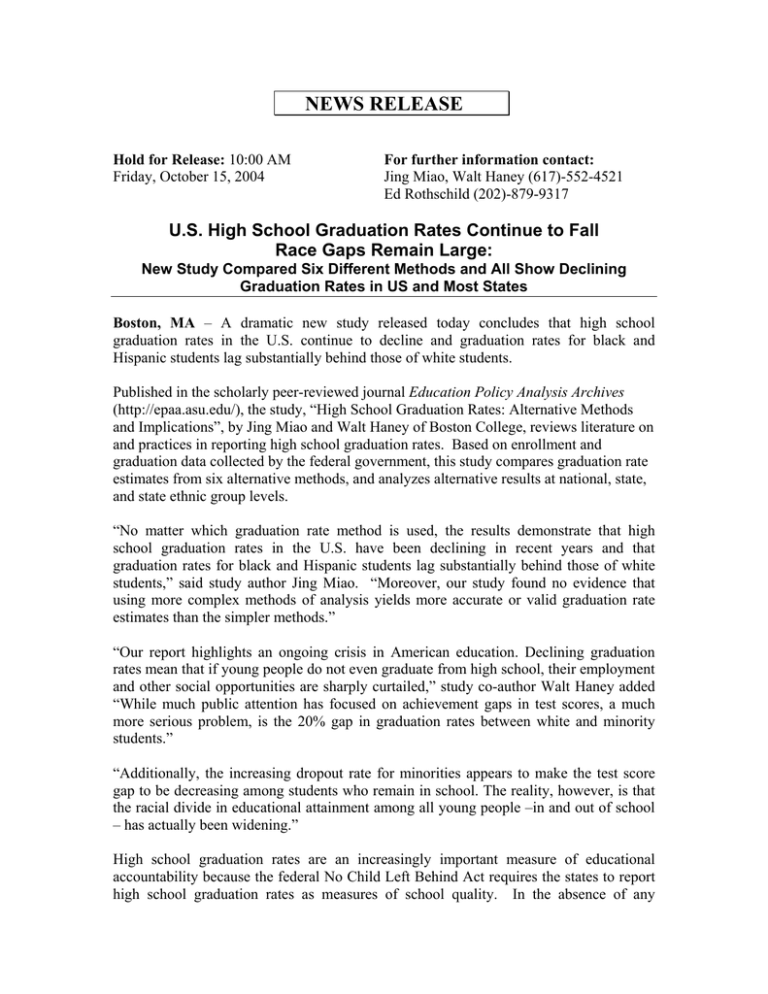NEWS RELEASE U.S. High School Graduation Rates Continue to Fall
advertisement

NEWS RELEASE Hold for Release: 10:00 AM Friday, October 15, 2004 For further information contact: Jing Miao, Walt Haney (617)-552-4521 Ed Rothschild (202)-879-9317 U.S. High School Graduation Rates Continue to Fall Race Gaps Remain Large: New Study Compared Six Different Methods and All Show Declining Graduation Rates in US and Most States Boston, MA – A dramatic new study released today concludes that high school graduation rates in the U.S. continue to decline and graduation rates for black and Hispanic students lag substantially behind those of white students. Published in the scholarly peer-reviewed journal Education Policy Analysis Archives (http://epaa.asu.edu/), the study, “High School Graduation Rates: Alternative Methods and Implications”, by Jing Miao and Walt Haney of Boston College, reviews literature on and practices in reporting high school graduation rates. Based on enrollment and graduation data collected by the federal government, this study compares graduation rate estimates from six alternative methods, and analyzes alternative results at national, state, and state ethnic group levels. “No matter which graduation rate method is used, the results demonstrate that high school graduation rates in the U.S. have been declining in recent years and that graduation rates for black and Hispanic students lag substantially behind those of white students,” said study author Jing Miao. “Moreover, our study found no evidence that using more complex methods of analysis yields more accurate or valid graduation rate estimates than the simpler methods.” “Our report highlights an ongoing crisis in American education. Declining graduation rates mean that if young people do not even graduate from high school, their employment and other social opportunities are sharply curtailed,” study co-author Walt Haney added “While much public attention has focused on achievement gaps in test scores, a much more serious problem, is the 20% gap in graduation rates between white and minority students.” “Additionally, the increasing dropout rate for minorities appears to make the test score gap to be decreasing among students who remain in school. The reality, however, is that the racial divide in educational attainment among all young people –in and out of school – has actually been widening.” High school graduation rates are an increasingly important measure of educational accountability because the federal No Child Left Behind Act requires the states to report high school graduation rates as measures of school quality. In the absence of any standard or federally required method for calculating graduation rates different states are employing different and non-comparable measures. As a result, different researchers have proposed and applied several specific graduation rate measures to try to compare performance differences among the states. The Miao-Haney research is the first study to compare six different graduation rate measures, at not just national, but also state and state-ethnic group levels. As a result, added Miao and Haney, “The study findings have important implications for implementing NCLB accountability requirements regarding high school graduation rates.” The full study is available in PDF format at the journal Education Policy Analysis Archives web site: http://epaa.asu.edu/epaa/v12n55/ The research reported in the Miao-Haney article was funded in part by the Ford Foundation. Reports on related research are available on the National Board on Educational Testing and Public Policy Website at http://www.bc.edu/nbetpp.


